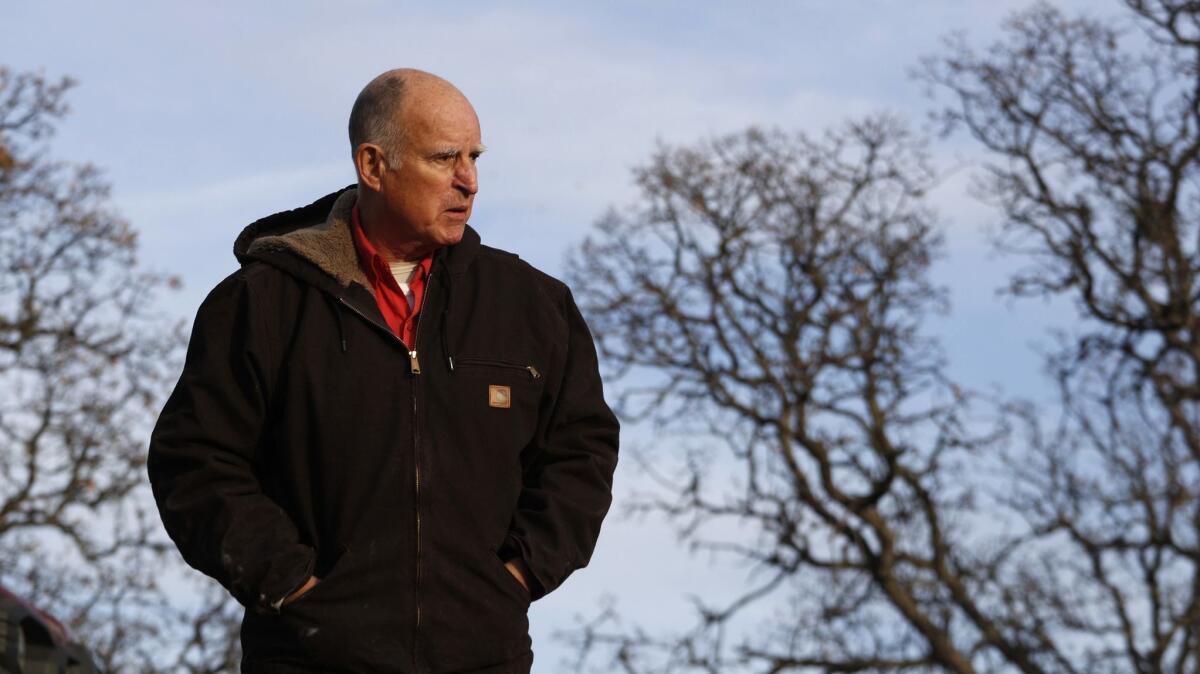Op-Ed: DNA tests could reveal if Kevin Cooper was wrongly convicted of murder. Why didn’t Jerry Brown order them?

- Share via
On Christmas Eve, shortly before the end of his final term as California’s governor, Jerry Brown ordered new DNA testing in a case that has been cited repeatedly as a possible miscarriage of justice.
But Brown inexplicably stopped short of ordering all the testing needed to finally settle whether Kevin Cooper was wrongly convicted for the savage 1983 murders of a Chino Hills family and a child staying at their house.
Cooper, a convicted burglar who had escaped from a nearby prison two days before the murders, was soon arrested, although the one family member who survived the attack, Joshua Ryen, 8, indicated immediately after being rushed to the hospital that there were three attackers and they were white. Cooper is African American.
Brown authorized DNA tests on only four of nine critically important items on an evidence list Cooper’s attorneys provided.
Over the decades Cooper has fought to prove his innocence, DNA technology has become so precise that testing of key evidence could finally determine whether or not he is guilty. It might even point to one or more others involved in the killing of Chino Hills chiropractors and Arabian horse breeders Peggy and Doug Ryen, both 41; their daughter Jessica, 10; and neighbor Christopher Hughes, 11.
That’s why Brown’s action is so puzzling.
Brown took an important step in allowing additional analysis and appointing a special master to oversee the testing. But he authorized DNA tests on only four of nine critically important items on an evidence list Cooper’s attorneys provided. They are a tan T-shirt believed worn by the killer; a never-tested bloody towel taken from the Ryen home; a hatchet believed to have been used in the murders; and ahatchet sheath that looks newer, found in the home where Cooper hid for two days after his escape.
Most puzzling of the items Brown did not authorize for testing is a clump of long light-brown hairs found clutched in the hand of Jessica, quite possibly yanked from the head of her killer and clearly not Cooper’s hair.
Josh Ryen, now in his 40s, pleaded for further investigation in a 2004 television interview on “48 Hours”: “The hair needs to be tested,” he said. “Her hand is clenched fighting for her life with hair in it. So, I want to know. I need to know.” Brown’s order won’t help.
Brown also did not authorize DNA testing of the victims’ fingernail scrapings, or items that could prove Cooper was framed, including a vial of Cooper’s blood drawn when he was arrested. It contains the blood preservative EDTA, as expected, but also the blood of at least one unknown person.
It was blood from this vial that Cooper’s attorneys believe was planted on the medium-size tan T-shirt that Cooper (who wears a size large) demanded in 2002 to be tested. When it revealed his blood, he and his attorneys were shocked, and in 2004 they got a retest. This time, EDTA was found in the blood spot, which Cooper’s attorneys said was proof that investigators took preserved blood from the vial taken when he was arrested and planted it on the shirt. The lab analyst later rescinded his EDTA finding, saying it was a result of contamination in his lab.
Brown’s order also excluded testing for EDTA of a tiny spot of blood determined to be Cooper’s that was found on a wall in the Ryen home. Someone else’s DNA was also found in the spot. This test is important because it was the lone bit of evidence putting Cooper at the crime scene; his attorneys believe it was planted.
The testing Brown authorized does include important items. Advanced DNA testing technology today might be able to identify the killer who wore the T-shirt 35 years ago by testing the inside collar and armpit material. It might pinpoint the user of the hatchet wielded in the attack. The orange towel should reveal the DNA of anyone who touched it. The hatchet was found near the T-shirt on the side of a road near the Ryen residence.
The San Bernardino County coroner initially said the victims were slain by three or four killers wielding a hatchet, knives and an ice pick, inflicting 144 wounds within four minutes. Several witnesses reported seeing three people in the Ryens’ stolen car shortly after the killings, and when the car was found by police a few days later, it had blood on three seats.
Five days after the slayings, a woman told a deputy she suspected her convicted-murderer boyfriend of being involved and gave the deputy bloody coveralls the boyfriend left at their house the night of the murders. She also identified the bloody tan T-shirt as one she bought, and said her boyfriend was wearing it the day of the killings; and she reported that his missing hatchet resembled the one identified as the murder weapon.
Sheriff Floyd Tidwell seemingly had a solid lead.
But when he learned that Cooper had escaped from a nearby minimum-security prison and hid out near the Ryens, he declared Cooper the lone suspect.
Enter the Fray: First takes on the news of the minute »
It’s jarring, of course, to think that investigators would have ignored evidence that didn’t fit their theory. But in a minority opinion about the case, U.S. 9th Circuit Court of Appeals Judge William C. Fletcher wrote: “In the course of their investigation, they discounted, disregarded, and discarded evidence pointing to other killers.” Fletcher has since said he believes the San Bernardino Sheriff’s Department framed Cooper.
The coveralls were discarded without being tested, and the woman who gave them to police was never called as a witness. The ex-boyfriend has consistently denied his involvement. Cooper’s attorneys have his DNA and will turn it over the state in the testing process.
As for Cooper, in a recent interview from a cramped visiting cell on death row, he talked about justice and the need for further tests: “People who want me executed say the families need closure. But closure is not justice. Truth is justice.”
Narda Zacchino is a journalist and author who has been researching the Kevin Cooper case for two years.
More to Read
A cure for the common opinion
Get thought-provoking perspectives with our weekly newsletter.
You may occasionally receive promotional content from the Los Angeles Times.










